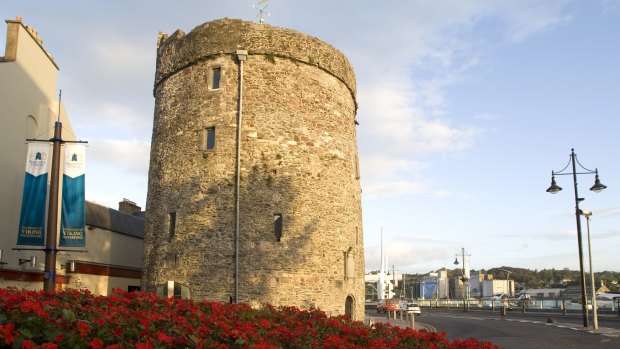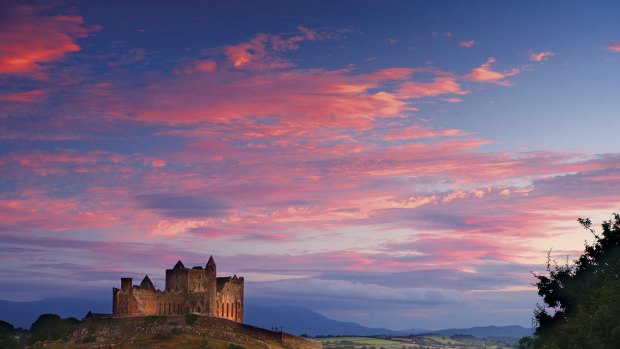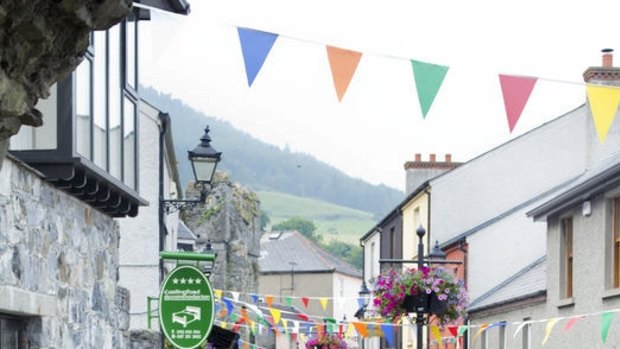This was published 8 years ago
Historic Heartlands: The magic of Ireland's ancient east

Reginald's Tower, Waterford.Credit: Bill Farr
Perhaps no place in the world inspires a greater feeling of coming home, especially for Australians with our many connections and historical ties, than Ireland.
For many, the feeling is induced by an ancestral pull drawing them back to their roots in this green story-filled island, at the edge of Europe. For others, it's caused by a simple melting of the heart caused by Ireland's unrivalled combination of dramatic landscapes, uniquely warm people, myth-riddled past, and rousing traditional and modern music.
Adding to Ireland's appeal is the ease of touring in a small nation where the next extraordinary historic site, welcoming town, acclaimed restaurant or inviting family-run hotel, is never far away.

The Rock of Cashel.
Ireland's Ancient East, stretching from County Louth to County Cork, epitomises all that's best about visiting the Emerald Isle.
Easily accessible from increasingly cosmopolitan Dublin, the east encompasses 5000 years of European history in a landscape of rolling hills, glacial valleys, expansive lakes and trout-filled rivers. It's heritage you can touch too, from megalithic tombs like Newgrange that are older than the pyramids, to 6th century monastic settlements like Glendalough, in the Wicklow mountains, to towns like Waterford that have grown up around a Viking core. To find out more visit www.ireland.com.
WHERE TO GO AND WHAT TO LOOK OUT FOR

Carlingford.
Medieval architecture, Celtic art.
It's really not a long way to Tipperary, nor to the other counties – Carlow, Kildare, Kilkenny, East Limerick, Laois and Offaly – in the Historic Heartlands section of Ireland's Ancient East and its historical riches make it worth the journey.
Set on an outcrop, 90 metres above Tipperary's Golden Vale, is the Rock of Cashel, as significant a collection of medieval architecture and Celtic art as exists in Europe. The region's other major cities include the thriving modern hub of Limerick which has pre-Medieval roots.
The town of Kilkenny, mixes profound history, in its 12th century castle and its medieval mile of buildings, with the modern rhythm of Irish life. Kilkenny can also claim excellent contemporary Irish food, but it is in the bars and the the traditional music scene where its creative spirit is strongest.
Kildare has the Irish National Stud and Gardens, founded in 1900 by Colonel William Hall Walker, who had an unshakeable conviction that a horse's horoscope determined its ability.
The aristocrat's strange belief didn't stop the Stud, and nearby racecourse The Curragh, from becoming central to the Irish passion for horseracing. With its intimate Japanese gardens, museum including the skeleton of the country's greatest stallion Arkle and Living Legends enclosure, it's a compelling attraction.
LAND OF 5000 DAWNS
Neolithic tombs, royal battlefields.
Easy to reach from both Belfast and Dublin, this section of Ireland's Ancient East comprises the counties of Louth, Meath, Cavan, Monaghan, Longford and Westmeath.
To its north is the hilly Cooley Peninsula, a European destination of Excellence, which reaches into the Irish sea and abuts Carlingford Lough. On its shores is the pretty village of Carlingford, its centre full of medieval buildings, including the old Town Gate and a castle said to be haunted by a headless ghost. But like many towns in the Ancient East, Carlingford wears its heritage lightly, alongside animated pubs. Its streets are thronged with revellers during its annual oyster festival, in August (pictured).
Further south, around the Boyne Valley, near Drogheda, Ireland's past, is literally etched into the landscape. As many as 40 Neolithic tombs, built more than 5000 years ago, are strewn across the countryside.
You can't travel far in Ireland's Ancient East without spotting a rambling castle. Among the most atmospheric is Slane Castle, perched above the Boyne River and dating back to 1785.
CELTIC COAST
Mountains, Titanic history.
This region, including the counties of Wicklow, Wexford, Waterford and East Cork has spectacular coastal and mountain scenery, historic towns, music coursing through its veins and world-class food and accommodation.
Brooding, flushed by streams and waterfalls and blanketed in mossy bog, the Wicklow mountains are the backdrop for Glendalough, a 6th century monastic settlement that developed around the hermit St Kevin, who drew many to this lonely glen by performing miracles.
Wicklow's mountains are dotted with lively villages like Avoca. Premium local seafood, including succulent mussels and prawns, is the hallmark of restaurants in Wicklow and nearby Wexford.
In Waterford, this area has a Viking town and a building, Reginald's Tower (pictured), dating back to 1002.
Many visitors will be drawn to the gorgeous seaside town of Cobh, the Titanic's last port of call before it sank in April 1912.
TAKE ME THERE
TOURING
Driving in the Ancient East is relatively stress-free, with a network of motorways linking Dublin with the major cities including Cork, Limerick and Waterford and also running through the north of the region to Belfast. Roads are mostly well signposted and distances are not great, but give yourself time to explore.
SLEEPING AND EATING
Among the outstanding accommodation and dining options in Ireland's Ancient East are:
Ghan House A restored, family-run Georgian house hotel, built in 1727, in the picturesque medieval town of Carlingford with an award-winning restaurant. Ghanhouse.com
Rathsallagh Country House Hotel Set amid 110 hectares of beautiful gardens in Dunlavin in West Wicklow, Rathsallagh is a restful retreat, with a modern Irish restaurant, close to the Irish National Stud. rathsallagh.com
Powerscourt Hotel and Spa Housed in a lavish Palladian mansion on the famous Estate at Enniskerry, County Wicklow, Powerscourt has a superb restaurant, Sika, and an indulgent spa. Powerscourthotel.com
Monart Spa Retreat Monart Spa Retreat is ensconced in an 18th century mansion in woodland near Enniscorthy, in County Wexford, and has a huge spa and Michelin recommended restaurant. monart.ie
Longueville House Housed in a 17th century manor, near Mallow, north of Cork city, Longueville's restaurant is in the talented hands of chef William O'Callaghan, who works with ingredients like salmon from the nearby Blackwater River and produce grown in the property's extensive gardens. longuevillehouse.ie
Sign up for the Traveller Deals newsletter
Get exclusive travel deals delivered straight to your inbox. Sign up now.